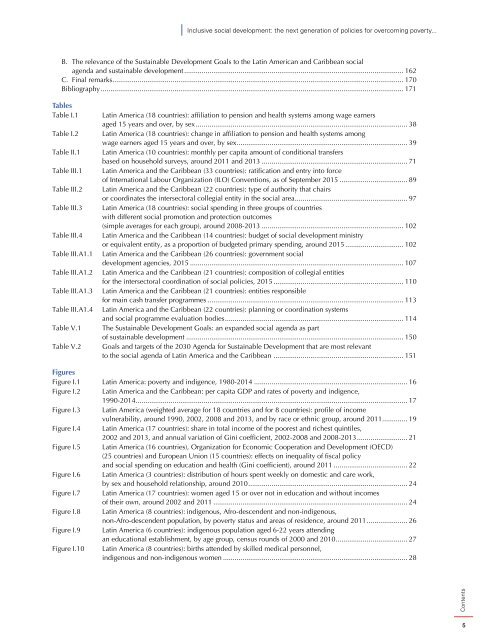Inclusive social development: The next generation of policies for overcoming poverty and reducing inequality in Latin America and the Caribbean
The Latin American and Caribbean region has achieved notable social development in the past decade. However, much remains to be done. The persisting challenges of defeating poverty once and for all and significantly reducing inequality are not only ethical imperatives but also conditions for making progress toward sustainable development, consistently with the recently adopted 2030 Agenda for Sustainable Development. Although the global economy is more complex and uncertain now than in previous years, and prospects for the region are not —in the short term, at least— particularly bright, it is crucial to secure the progress made in social development in the past decade and lose no time in tackling unresolved issues in areas where progress has been insufficient.
The Latin American and Caribbean region has achieved notable social development in the past decade. However, much remains to be done. The persisting challenges of defeating poverty once and for all and significantly reducing inequality are not only ethical imperatives but also conditions for making progress toward sustainable development, consistently with the recently adopted 2030 Agenda for Sustainable Development.
Although the global economy is more complex and uncertain now than in previous years, and prospects for the region are not —in the short term, at least— particularly bright, it is crucial to secure the progress made in social development in the past decade and lose no time in tackling unresolved issues in areas where progress has been insufficient.
Create successful ePaper yourself
Turn your PDF publications into a flip-book with our unique Google optimized e-Paper software.
<strong>Inclusive</strong> <strong>social</strong> <strong>development</strong>: <strong>the</strong> <strong>next</strong> <strong>generation</strong> <strong>of</strong> <strong>policies</strong> <strong>for</strong> <strong>overcom<strong>in</strong>g</strong> <strong>poverty</strong>...<br />
B. <strong>The</strong> relevance <strong>of</strong> <strong>the</strong> Susta<strong>in</strong>able Development Goals to <strong>the</strong> Lat<strong>in</strong> <strong>America</strong>n <strong>and</strong> <strong>Caribbean</strong> <strong>social</strong><br />
agenda <strong>and</strong> susta<strong>in</strong>able <strong>development</strong>.................................................................................................................. 162<br />
C. F<strong>in</strong>al remarks....................................................................................................................................................... 170<br />
Bibliography............................................................................................................................................................. 171<br />
Tables<br />
Table I.1<br />
Table I.2<br />
Table II.1<br />
Table III.1<br />
Table III.2<br />
Table III.3<br />
Table III.4<br />
Table III.A1.1<br />
Table III.A1.2<br />
Table III.A1.3<br />
Table III.A1.4<br />
Table V.1<br />
Table V.2<br />
Lat<strong>in</strong> <strong>America</strong> (18 countries): affiliation to pension <strong>and</strong> health systems among wage earners<br />
aged 15 years <strong>and</strong> over, by sex.............................................................................................................. 38<br />
Lat<strong>in</strong> <strong>America</strong> (18 countries): change <strong>in</strong> affiliation to pension <strong>and</strong> health systems among<br />
wage earners aged 15 years <strong>and</strong> over, by sex......................................................................................... 39<br />
Lat<strong>in</strong> <strong>America</strong> (10 countries): monthly per capita amount <strong>of</strong> conditional transfers<br />
based on household surveys, around 2011 <strong>and</strong> 2013............................................................................ 71<br />
Lat<strong>in</strong> <strong>America</strong> <strong>and</strong> <strong>the</strong> <strong>Caribbean</strong> (33 countries): ratification <strong>and</strong> entry <strong>in</strong>to <strong>for</strong>ce<br />
<strong>of</strong> International Labour Organization (ILO) Conventions, as <strong>of</strong> September 2015.................................... 89<br />
Lat<strong>in</strong> <strong>America</strong> <strong>and</strong> <strong>the</strong> <strong>Caribbean</strong> (22 countries): type <strong>of</strong> authority that chairs<br />
or coord<strong>in</strong>ates <strong>the</strong> <strong>in</strong>tersectoral collegial entity <strong>in</strong> <strong>the</strong> <strong>social</strong> area........................................................... 97<br />
Lat<strong>in</strong> <strong>America</strong> (18 countries): <strong>social</strong> spend<strong>in</strong>g <strong>in</strong> three groups <strong>of</strong> countries<br />
with different <strong>social</strong> promotion <strong>and</strong> protection outcomes<br />
(simple averages <strong>for</strong> each group), around 2008-2013.......................................................................... 102<br />
Lat<strong>in</strong> <strong>America</strong> <strong>and</strong> <strong>the</strong> <strong>Caribbean</strong> (14 countries): budget <strong>of</strong> <strong>social</strong> <strong>development</strong> m<strong>in</strong>istry<br />
or equivalent entity, as a proportion <strong>of</strong> budgeted primary spend<strong>in</strong>g, around 2015............................... 102<br />
Lat<strong>in</strong> <strong>America</strong> <strong>and</strong> <strong>the</strong> <strong>Caribbean</strong> (26 countries): government <strong>social</strong><br />
<strong>development</strong> agencies, 2015............................................................................................................... 107<br />
Lat<strong>in</strong> <strong>America</strong> <strong>and</strong> <strong>the</strong> <strong>Caribbean</strong> (21 countries): composition <strong>of</strong> collegial entities<br />
<strong>for</strong> <strong>the</strong> <strong>in</strong>tersectoral coord<strong>in</strong>ation <strong>of</strong> <strong>social</strong> <strong>policies</strong>, 2015.................................................................... 110<br />
Lat<strong>in</strong> <strong>America</strong> <strong>and</strong> <strong>the</strong> <strong>Caribbean</strong> (21 countries): entities responsible<br />
<strong>for</strong> ma<strong>in</strong> cash transfer programmes...................................................................................................... 113<br />
Lat<strong>in</strong> <strong>America</strong> <strong>and</strong> <strong>the</strong> <strong>Caribbean</strong> (22 countries): plann<strong>in</strong>g or coord<strong>in</strong>ation systems<br />
<strong>and</strong> <strong>social</strong> programme evaluation bodies............................................................................................. 114<br />
<strong>The</strong> Susta<strong>in</strong>able Development Goals: an exp<strong>and</strong>ed <strong>social</strong> agenda as part<br />
<strong>of</strong> susta<strong>in</strong>able <strong>development</strong>................................................................................................................. 150<br />
Goals <strong>and</strong> targets <strong>of</strong> <strong>the</strong> 2030 Agenda <strong>for</strong> Susta<strong>in</strong>able Development that are most relevant<br />
to <strong>the</strong> <strong>social</strong> agenda <strong>of</strong> Lat<strong>in</strong> <strong>America</strong> <strong>and</strong> <strong>the</strong> <strong>Caribbean</strong> .................................................................... 151<br />
Figures<br />
Figure I.1 Lat<strong>in</strong> <strong>America</strong>: <strong>poverty</strong> <strong>and</strong> <strong>in</strong>digence, 1980-2014................................................................................ 16<br />
Figure I.2 Lat<strong>in</strong> <strong>America</strong> <strong>and</strong> <strong>the</strong> <strong>Caribbean</strong>: per capita GDP <strong>and</strong> rates <strong>of</strong> <strong>poverty</strong> <strong>and</strong> <strong>in</strong>digence,<br />
1990-2014............................................................................................................................................. 17<br />
Figure I.3 Lat<strong>in</strong> <strong>America</strong> (weighted average <strong>for</strong> 18 countries <strong>and</strong> <strong>for</strong> 8 countries): pr<strong>of</strong>ile <strong>of</strong> <strong>in</strong>come<br />
vulnerability, around 1990, 2002, 2008 <strong>and</strong> 2013, <strong>and</strong> by race or ethnic group, around 2011.............. 19<br />
Figure I.4 Lat<strong>in</strong> <strong>America</strong> (17 countries): share <strong>in</strong> total <strong>in</strong>come <strong>of</strong> <strong>the</strong> poorest <strong>and</strong> richest qu<strong>in</strong>tiles,<br />
2002 <strong>and</strong> 2013, <strong>and</strong> annual variation <strong>of</strong> G<strong>in</strong>i coefficient, 2002-2008 <strong>and</strong> 2008-2013........................... 21<br />
Figure I.5 Lat<strong>in</strong> <strong>America</strong> (16 countries), Organization <strong>for</strong> Economic Cooperation <strong>and</strong> Development (OECD)<br />
(25 countries) <strong>and</strong> European Union (15 countries): effects on <strong><strong>in</strong>equality</strong> <strong>of</strong> fiscal policy<br />
<strong>and</strong> <strong>social</strong> spend<strong>in</strong>g on education <strong>and</strong> health (G<strong>in</strong>i coefficient), around 2011....................................... 22<br />
Figure I.6 Lat<strong>in</strong> <strong>America</strong> (3 countries): distribution <strong>of</strong> hours spent weekly on domestic <strong>and</strong> care work,<br />
by sex <strong>and</strong> household relationship, around 2010................................................................................... 24<br />
Figure I.7 Lat<strong>in</strong> <strong>America</strong> (17 countries): women aged 15 or over not <strong>in</strong> education <strong>and</strong> without <strong>in</strong>comes<br />
<strong>of</strong> <strong>the</strong>ir own, around 2002 <strong>and</strong> 2011..................................................................................................... 24<br />
Figure I.8 Lat<strong>in</strong> <strong>America</strong> (8 countries): <strong>in</strong>digenous, Afro-descendent <strong>and</strong> non-<strong>in</strong>digenous,<br />
non-Afro-descendent population, by <strong>poverty</strong> status <strong>and</strong> areas <strong>of</strong> residence, around 2011...................... 26<br />
Figure I.9 Lat<strong>in</strong> <strong>America</strong> (6 countries): <strong>in</strong>digenous population aged 6-22 years attend<strong>in</strong>g<br />
an educational establishment, by age group, census rounds <strong>of</strong> 2000 <strong>and</strong> 2010...................................... 27<br />
Figure I.10 Lat<strong>in</strong> <strong>America</strong> (8 countries): births attended by skilled medical personnel,<br />
<strong>in</strong>digenous <strong>and</strong> non-<strong>in</strong>digenous women................................................................................................ 28<br />
Contents<br />
5


















